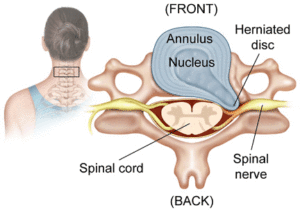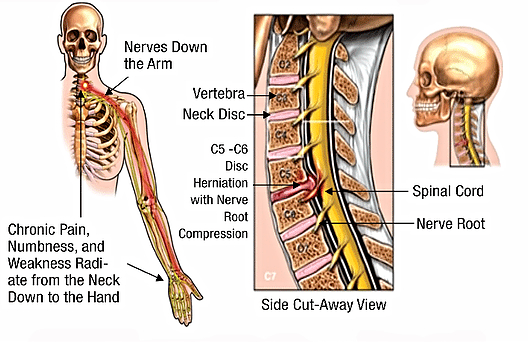Guide to Cervical Disc Herniation: Understanding, Symptoms, Diagnosis, and Physiotherapy Recovery

Navigating through neck disc problems like herniation, bulges, or slipped discs can be challenging. This guide is designed to provide you with a comprehensive overview, helping you comprehend the basics, recognize symptoms, understand the diagnosis process, and discover how physiotherapy at SimplyAlign Rehabilitation Centers in Scarborough and Woodbridge, Canada, can support your recovery journey.
What is Cervical Disc Herniation?
Your neck is home to intervertebral discs that act as cushions for your spine. Sometimes these discs encounter issues. They might bulge out, tear, or exert pressure on nerves, leading to discomfort. While people often refer to this as a “slipped disc,” that’s not entirely accurate.
Cervical disc herniation is when one of the soft cushions between the bones in your neck gets damaged. These cushions, called discs, help your neck move and absorb shocks. When a disc gets hurt, it can push out and press on important nerves or your spinal cord. This can make your neck, shoulders, and even your fingers hurt. You might also feel strange sensations like numbness or tingling. Things like getting older, bad posture, or injuries can cause this problem.
Doctors use tests like pictures of your neck (MRI or X-rays) to figure out what’s wrong. Treatment can involve exercises, physiotherapy, or even surgery, depending on how bad it is. If your neck is bothering you, it’s important to talk to a doctor and consult a physiotherapist.

What are the symptoms of Cervical Disc Herniation?
Pay attention if you experience neck pain that extends to your shoulders, arms, or even your fingers. Understanding the symptoms associated with these conditions is crucial for timely diagnosis and treatment.

- Pain and Discomfort: Describe the characteristic pain felt in the neck, shoulders, arms, and fingers. Explain how the pain might radiate down the arms and lead to muscle stiffness.
- Numbness and Tingling: Discuss how pressure on nerves can cause numbness, tingling, and a pins-and-needles sensation in the affected areas.
- Neck Mobility Issues: Highlight difficulties in moving the neck, including reduced range of motion and stiffness.
- Headaches and Migraines: Explain how cervical spine issues can contribute to headaches and migraines, especially if there’s nerve compression.
What are the factors behind these issues?

Several factors contribute to these problems.
- Aging can cause wear and tear on the discs.
- Poor posture and incorrect sitting habits can strain your neck.
- Repetitive movements, especially in certain jobs, can also contribute to disc problems. Traumatic events like accidents or falls can further exacerbate these issues.
How can you diagnose Cervical Disc Herniation?
Our team of doctors and physiotherapists collaborate to diagnose your condition. They engage in conversations with you about your symptoms and might ask you to perform various neck movements. Sometimes, diagnostic tests like MRI or X-rays are employed to visualize your neck’s internal state accurately.
Navigating Recovery with Physiotherapy
The path to recovery begins with seeking help promptly. Our skilled physiotherapists act as experienced guides, creating tailored plans that cater to your unique needs. These plans aim to alleviate pain, enhance mobility, and strengthen your neck.
How we at Simply Align Rehab Use Our Expert Physiotherapy Techniques for Improvement
- Hands-On Assistance: Our therapists provide gentle neck movements to alleviate discomfort.
- Beneficial Exercises: Tailored exercises work to strengthen neck muscles, facilitating easier movement and enhanced flexibility.
- Rectifying Posture: Learning proper sitting and standing posture reduces strain on your neck.
- Pain Management: Using Radio Frequency, Tecar therapy, laser, shockwave and Super Induction therapies.
- Gentle Stretching: Controlled stretching may be utilized to alleviate pressure, with guidance from your therapist.
Stages of Healing and Reaching Normalcy
- Diminishing Discomfort: The initial focus is on reducing pain and discomfort.
- Progressive Steps: Gradually, you’ll regain the ability to engage in activities you previously enjoyed.
- Ongoing Monitoring: Our therapists ensure your progress is tracked, and modifications to the plan are made if necessary.
Facing neck disc challenges can be daunting, but you’re not alone. At SimplyAlign Rehabilitation Centers in Scarborough and Woodbridge, Canada, our dedicated team is here to guide you toward a healthier neck. Early intervention and adherence to your physiotherapy plan can set you on the path to a more comfortable and active life.
Contact us at SimplyAlign Rehabilitation Centers in Scarborough and Woodbridge, Canada, to Begin Your Recovery Journey Today!
Visit Simply Align Rehab Physio in Scarborough/Toronto or Woodbridge/Vaughan or you can always call or text us for your Physiotherapy or Chiropractor needs in Toronto at (416) 438-3230 or For Physiotherapy or Chiropractor need in Vaughan (Woodbridge) at (905) 638-9840.
